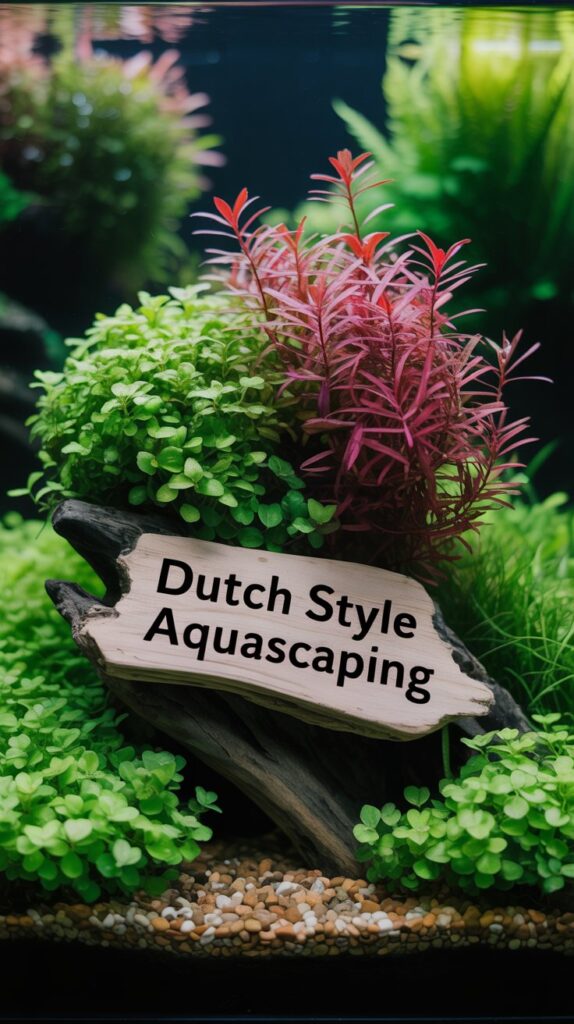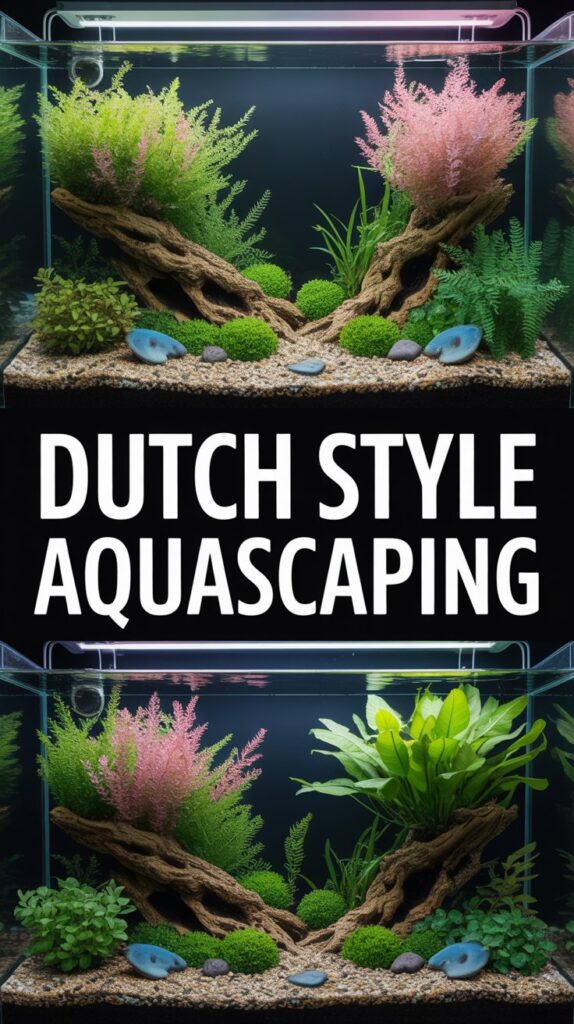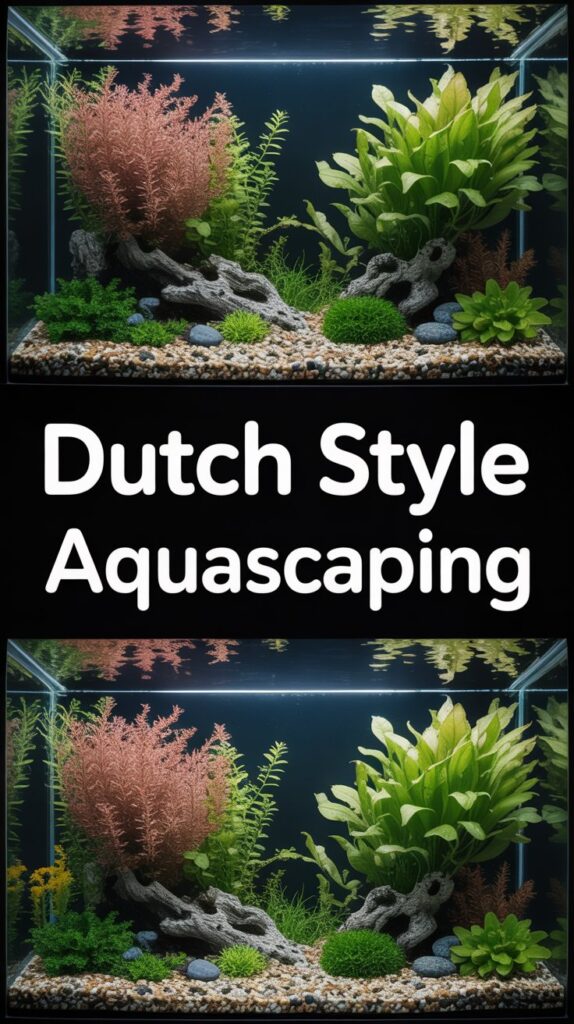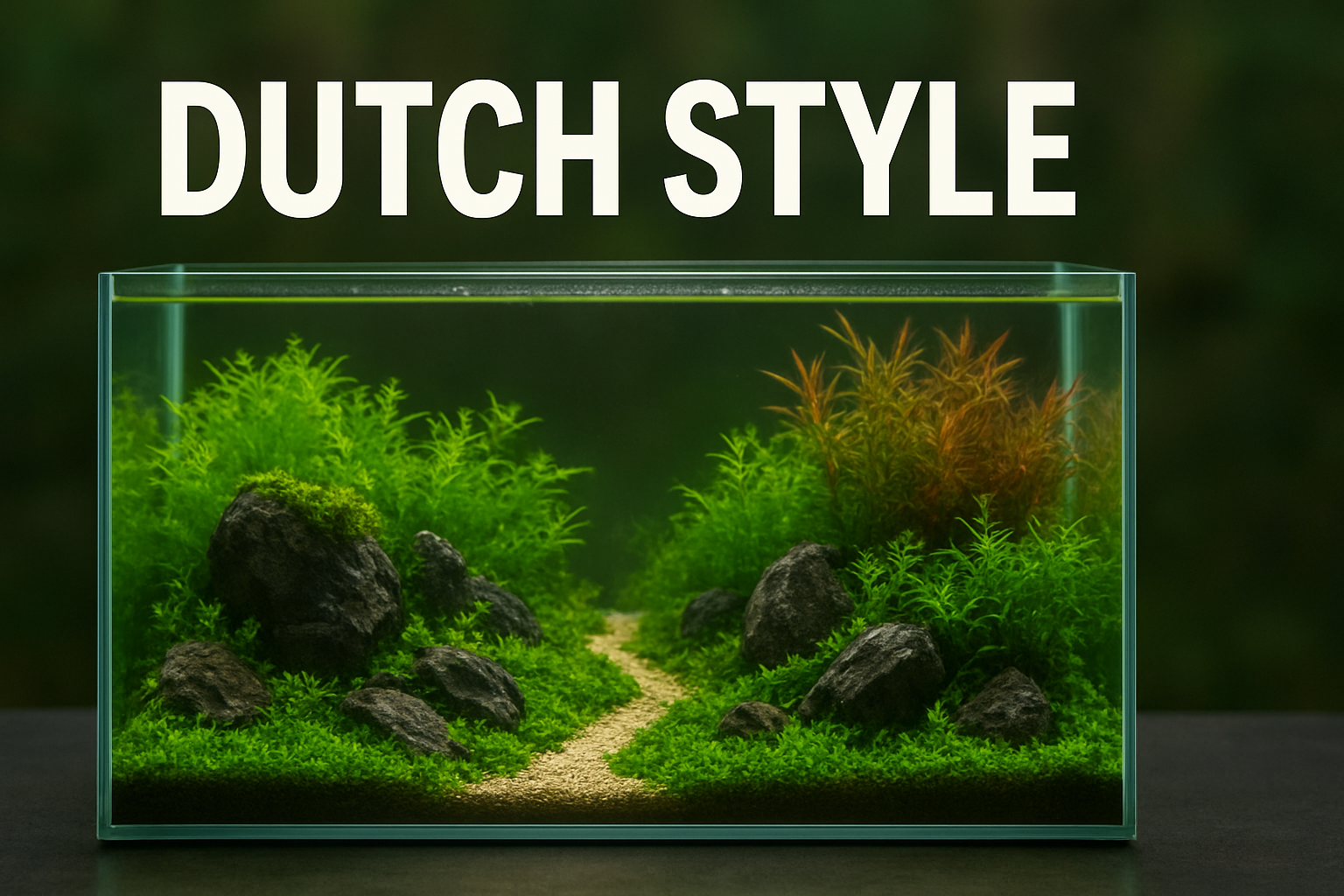Aquascaping has become one of the most admired branches of aquarium keeping. While many styles have emerged over the years—such as Nature, Iwagumi, and Jungle—the Dutch style aquascaping remains one of the most elegant, traditional, and structured approaches. This style emphasizes plant arrangement, color contrasts, and depth, resembling a meticulously designed underwater botanical garden.
In this article, we’ll explore everything you need to know about Dutch style aquascaping, including its history, characteristics, plant selection, layout rules, step-by-step setup, maintenance, common mistakes, and FAQs. Whether you are a beginner exploring aquascaping or an experienced aquarist looking to refine your craft, this guide will help you master the Dutch approach.
What is Dutch Style Aquascaping?
Dutch style aquascaping is one of the oldest aquarium design methods, originating in the Netherlands in the 1930s. Unlike other styles that highlight rocks, wood, or natural landscapes, Dutch aquascaping focuses almost entirely on plants.
It is often described as an “aquatic garden” because it prioritizes dense plant growth, layering, and the use of different plant species arranged in a structured, organized manner. Hardscape materials like rocks and driftwood are rarely used, if at all.
The goal of Dutch aquascaping is to create a visually balanced, colorful, and lush underwater garden that looks as if it could exist in nature, yet is clearly designed with artistry and precision.
Key Characteristics of Dutch Style Aquascaping

To understand what makes Dutch aquascaping unique, let’s break down its defining features:
- Plant-Centered Design – Unlike Nature or Iwagumi styles, Dutch style rarely uses rocks or driftwood. Plants are the main design elements.
- Structured Layout – Plants are arranged in terraces, rows, or groups, often following strict placement rules to achieve harmony.
- Contrast and Color – Different plant species are chosen for contrasting colors, leaf shapes, and textures.
- Layering and Depth – Foreground, midground, and background plants are carefully placed to create depth and perspective.
- Street Effect – A famous Dutch design technique where tall plants are arranged in parallel rows, creating pathways or “streets” that lead the eye to the background.
- Minimal Hardscape – Rocks, driftwood, and ornaments are kept to a minimum, if used at all.
- Balance and Symmetry – Dutch aquascapes often have symmetrical layouts or balanced asymmetry, avoiding randomness.
History of Dutch Style Aquascaping
The Dutch style was first developed in the early 20th century in the Netherlands. The Nederlandse Bond Aqua Terra (NBAT), or the Dutch Aquarium Society, played a major role in standardizing this style. They even created aquascaping competitions where strict judging rules evaluated aquariums based on layout, plant health, color harmony, and depth.
Dutch aquascaping dominated the aquarium hobby until the 1990s, when Takashi Amano introduced the Nature Aquarium style from Japan. While Amano’s style emphasized natural landscapes and hardscape elements, the Dutch style remained popular among aquarists who loved structured plant-based designs.
Today, Dutch aquascaping is still respected worldwide, especially in competitions, where it represents tradition, discipline, and plant mastery.
Advantages of Dutch Style Aquascaping
- Aesthetic Elegance – Creates a colorful, garden-like appearance.
- Focus on Plants – Ideal for plant enthusiasts who want to showcase different species.
- Minimal Hardscape Costs – Reduces reliance on expensive rocks or driftwood.
- Structured Approach – Provides clear design rules, making it easier to plan.
- Educational – Helps aquarists learn about plant care, growth rates, and maintenance.
Challenges of Dutch Style Aquascaping

- Requires Plant Knowledge – Success depends on selecting and maintaining a wide variety of plants.
- High Maintenance – Frequent trimming, fertilization, and CO₂ dosing are needed.
- Complex Layout Rules – Strict guidelines make it harder for beginners to execute properly.
- Limited Fish Role – Fish are often added only for movement, not as focal points.
Choosing Plants for Dutch Style Aquascaping
Plant selection is the heart of Dutch aquascaping. A typical Dutch tank may contain 20 or more different species, carefully arranged for maximum contrast.
Foreground Plants
- Dwarf Hairgrass (Eleocharis parvula)
- Glossostigma elatinoides
- Staurogyne repens
- Cryptocoryne parva
Midground Plants
- Alternanthera reineckii
- Hygrophila polysperma
- Cryptocoryne wendtii
- Java Fern (Microsorum pteropus)
Background Plants
- Ludwigia repens
- Rotala rotundifolia
- Vallisneria spiralis
- Cabomba caroliniana
Accent Plants
- Tiger Lotus (Nymphaea lotus)
- Echinodorus species (Amazon Swords)
- Red Ludwigia for striking color contrast
The key is to mix different leaf shapes, sizes, and colors to achieve balance and visual diversity.
Design Principles in Dutch Style Aquascaping

Dutch aquascaping is guided by specific design principles:
1. Grouping
Plants should be grouped in blocks or bunches, not scattered randomly. Each group typically contains 10–20 stems for impact.
2. Layering
Foreground, midground, and background plants should flow smoothly to create depth.
3. Contrast
Place plants with different leaf shapes and colors next to each other for visual interest.
4. Focal Point
At least one strong focal point is required, usually achieved with a brightly colored or large-leaved plant.
5. Street Effect
Rows of tall plants create perspective lines that guide the viewer’s eye toward the background.
6. Plant Height Gradation
Plants should gradually increase in height from front to back, avoiding sudden jumps.
Equipment for Dutch Style Aquascaping
Since plants dominate Dutch aquascapes, the right equipment is essential:
- Tank – A large tank (75–125 gallons) is common, but smaller Dutch tanks are possible.
- Lighting – Strong LED or T5 lighting is needed for dense plant growth.
- CO₂ Injection – Essential for lush, colorful, and fast-growing plants.
- Filtration – Canister filters provide strong water flow and biological support.
- Substrate – Nutrient-rich soils (ADA Aqua Soil, Fluval Stratum, Tropica Soil).
- Fertilization – Regular dosing of macro (NPK) and micro (iron, magnesium, etc.) nutrients.
Step-by-Step Guide to Creating a Dutch Style Aquascape

Step 1: Planning
- Sketch a rough layout.
- Select 15–20 plant species with contrasting colors and textures.
Step 2: Substrate Layer
- Add a nutrient-rich substrate.
- Consider layering with root tabs for heavy root feeders.
Step 3: Planting
- Plant foreground species first, then midground, then background.
- Group plants in clusters rather than scattering.
Step 4: Layout Design
- Position focal plants off-center (using the rule of thirds).
- Arrange plants in terraces or rows for depth.
- Use the “street effect” for perspective.
Step 5: Equipment Setup
- Install lighting, filtration, and CO₂.
Step 6: Filling with Water
- Fill the aquarium slowly to avoid uprooting plants.
Step 7: Cycling the Tank
- Allow 3–6 weeks for biological stability before adding fish.
Step 8: Adding Fish and Invertebrates
- Choose small, schooling fish like tetras or rasboras.
- Add shrimp or snails for algae control.
Maintenance of Dutch Style Aquascaping
- Trimming – Regular pruning keeps plants in shape and prevents overcrowding.
- Fertilization – Weekly dosing of liquid fertilizers and root tabs.
- CO₂ Regulation – Monitor levels to avoid harming fish while supporting plants.
- Algae Management – Maintain balance of light, nutrients, and CO₂.
- Water Changes – 20–30% weekly to remove excess nutrients.
Common Mistakes in Dutch Style Aquascaping
- Overcrowding Plants – Leads to chaos instead of order.
- Lack of Contrast – Choosing plants that look too similar diminishes visual impact.
- Neglecting Maintenance – Without regular trimming, the tank quickly loses its shape.
- Skipping CO₂ and Fertilizers – Results in poor plant growth and algae blooms.
- Too Much Hardscape – Defeats the purpose of Dutch style.
Conclusion
Dutch style aquascaping is a timeless and elegant aquarium design that emphasizes lush plant growth, structured layouts, and visual harmony. While it requires dedication, knowledge of plants, and consistent maintenance, the result is a breathtaking underwater garden that showcases the beauty of aquatic plants like no other style.
By following the principles of grouping, layering, contrast, and perspective, anyone can master the Dutch style and create an aquarium that looks both natural and artistic. Whether you’re a beginner or a seasoned aquascaper, Dutch aquascaping offers a rewarding challenge and an opportunity to turn your aquarium into a living masterpiece.
FAQs about Dutch Style Aquascaping
Q1: What makes Dutch style aquascaping different from other styles?
Dutch style focuses almost entirely on plants, unlike Nature or Iwagumi styles, which rely heavily on rocks and driftwood.
Q2: Do I need CO₂ injection for Dutch aquascaping?
Yes, CO₂ is highly recommended to support dense plant growth and vibrant colors.
Q3: How many plant species should I use in a Dutch aquascape?
A typical Dutch tank uses at least 15–20 species, carefully arranged for contrast and harmony.
Q4: Can beginners try Dutch style aquascaping?
Yes, but it requires dedication and learning plant care basics. Beginners may want to start small before attempting large Dutch tanks.
Q5: What fish are best for Dutch aquascaping?
Small, schooling fish like Neon Tetras, Ember Tetras, Harlequin Rasboras, and peaceful shrimp/snails work best.
Q6: How big should a Dutch style aquarium be?
Larger tanks (75+ gallons) are ideal, but smaller tanks can also be designed in Dutch style with fewer plants.
Q7: Do Dutch aquascapes use hardscape materials?
Hardscape is minimal or completely absent. The focus is always on plants.
Q8: How often should I trim plants in Dutch aquascaping?
Every 1–2 weeks, depending on growth, to maintain structured rows and terraces.
Q9: Is Dutch aquascaping expensive?
It can be costly due to CO₂ systems, fertilizers, and lighting, but long-term rewards outweigh the investment.
Q10: What is the “street effect” in Dutch style aquascaping?
It is a design technique where tall plants are arranged in rows to create perspective and guide the viewer’s eye to the background.

